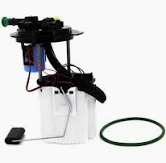It will save you some time in the event of fuel pump issues that cause your engine to get more serious failure. The first thing to check is fuel pressure. The majority of modern day vehicles require 35 – 65 PSI inorder for the vehicle run properly. The fuel pressure can be measured by connecting a fuel pressure gauge to the valve of the fuel rail. In case the reading is below manufacturer-specified, it could mean that the fuel pump may be failing and so might not be delivering enough gas to motor. This method is quite useful as low pressure is the first thing to check when its about how to tell you if your fuel pump has gone out and a long term drop in pressure will lead to basing of the engine.
Then she'll be for you to hear the priming sound of fuel pump when key is switched in order to "on" setting. A healthy fuel pump will make a fairly quiet hum or whine during operation as it pressurizes the fuel system. If you hear any sound, no matter how faint then this means the pump is working and there might be an electrical problem because it should spray some water. 30% of fuel pump trouble is really a wiring or fuse issue. The first things to check are the fuse box and a quick look at whether your fuel pump's appropriate fuse still in place. Changing a fuse or relay is much easier than swapping out the entire fuel pump.
Step two is inspecting fuel filters. If fuel pressure is tested as part of the diagnosis, a clogged filter may cause low pressures and engine misfires similar to symptoms related with a failing fuel pump. They become clogged with debris and impurities as they filter the fuel, eventually getting blocked to restrict proper flow of gasoline. In some cases, changing out the fuel filter with a fresh one can solve this problem and spare you from going the whole way to replace your pump. Normally speaking, it is a good idea to replace your fuel filter every 20-30 miles depending on how you drive.
Also, inspect for blockages and/or leaks in the fuel line. When fuel lines are damaged by rust, debris or other factors they can result in a decline of pressure, or even keep the engine from receiving any fuel at all. It not only reduces fuel pressure when it leaks, but also has a definite fire hazard. Check the fuel lines for cracks, wear or disconnection to determine if it's a problem with your pump and not further down in you system. Fuel line leaks are blamed for about 10% of fuel delivery problems according to figures from the automotive industry.

The fuel pump relay can be tested next as a diagnostic step. This relay functions to bypass the pump electrical power. Sometimes the pump will be fine, but you'll have a bad relay and that's what won't make it turn on. Relays can be tested with an ohmmeter or exchanged for a similar relay from the fuse box. If the vehicle starts when swapping relays, the relay is your issue not finally that pump.
The average life expectancy of a fuel pump is about between 100,000 to 200,000 miles and the sooner before this range your electric fuel pump fails, the more likely it has failed as a result of electrical problems instead of other physical issues such dirty or contaminated gasoline. At this mileage, once the car experiences symptoms such as sputtering or cranking but not starting (aka long crank), then a severely loss of power it may mean that you do have to replace your fuel pump entirely.
If these three steps do not solve the problem, then you may have to replace your fuel pump. An early diagnosis of a squeaking pump can save hundreds of dollars in engine issues later. Visit Fuel Pump to search for suitable replacements for your vehicle!